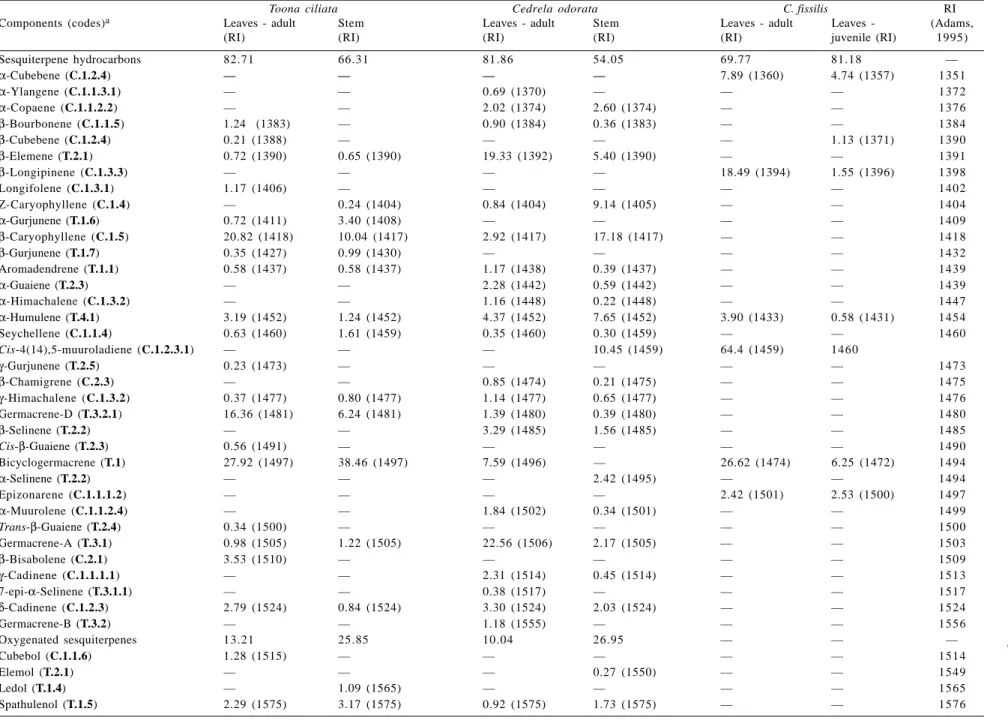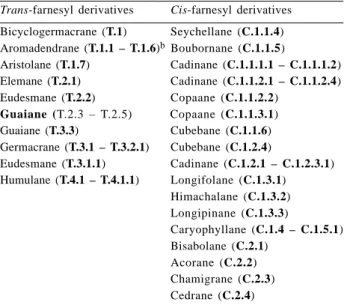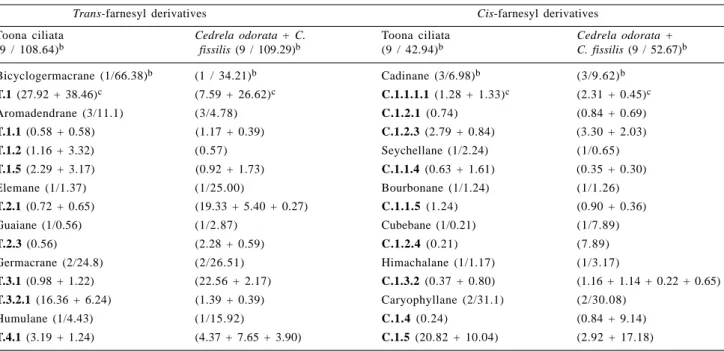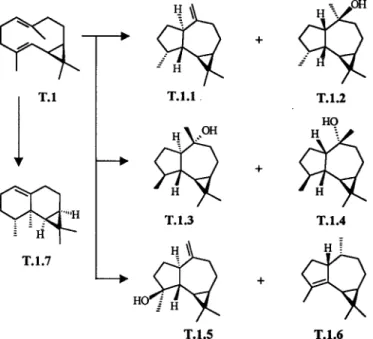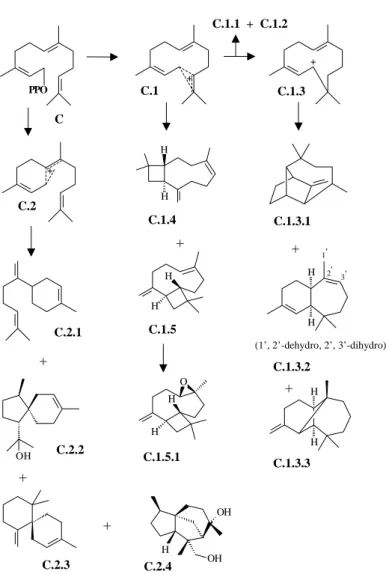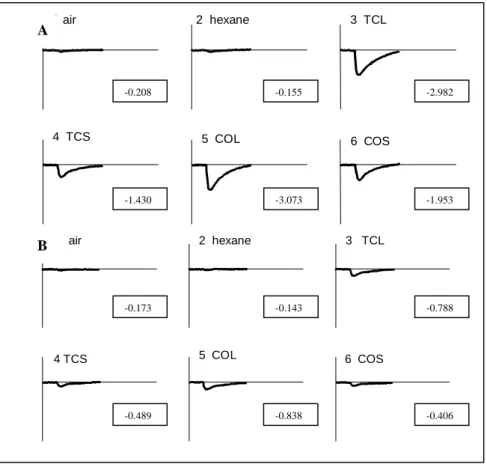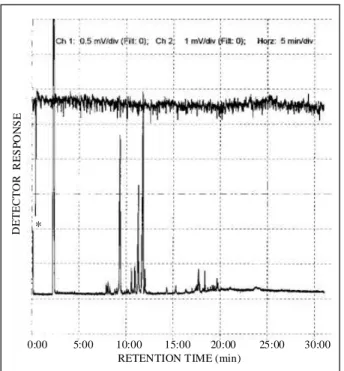Article
Essential Oils of Toona and Cedrela Species (Meliaceae):
Taxonomic and Ecological Implications
Beatriz H. L. N. S. Maiaa, José R. de Paulaa, Josué Sant’Anaa, M. Fátima das G. F. da Silvaa,*, João B. Fernandesa, Paulo C. Vieiraa, Merilene do S. S. Costab, Orlando S. Ohashib and José Natalino M. Silvac
a
Departamento de Química, Universidade Federal de São Carlos, CP 676, 13565-905 São Carlos, SP, Brazil b
Faculdade de Ciências Agrárias do Pará, Belém, PA, Brazil c
Empresa Brasileira de Pesquisa Agropecuária, Belém, PA, Brazil
Os óleos essenciais de Toona ciliata, Cedrela odorata e C. fissilis foram analisados por CG-EM. Cedrela apresentou em maior percentagem sesquiterpenos formados a partir do precursor pirofosfato de cis- e trans-farnesila. Já Toona mostra uma tendência em produzir principalmente sesquiterpenos derivados do pirofosfato de trans-farnesila. Estes resultados confirmam que a classificação destes dois gêneros em uma mesma tribo, Cedreleae, continua problemática. As respostas em eletroantenogramas médios (EAGs) dos óleos essenciais de T. ciliata e C. odorata, em fêmeas de
Hypsipyla grandella, foram significativamente maiores que aquelas obtidas em machos, sugerindo
que as fêmeas utilizariam os odores destes óleos para a seleção da planta hospedeira (gêneros de Swietenioidea) e na escolha de locais para oviposição.
The essential oils of Toona ciliata, Cedrela odorata and C. fissilis have been analysed by GC-MS. Cedrela contains the main sesquiterpenes formed from the cis- and trans-farnesyl pyrophosphate. In contrast, Toona tend to produce mainly sesquiterpenes formed from the trans-precursor. These results show that the affiliation of Toona in the tribe Cedreleae together with Cedrela is still rather problematic. Mean electroantennogram responses (EAGs) to the essential oils from T. ciliata and C.
odorata, in Hypsipyla grandella females were significantly greater than those obtained for males,
suggesting that females would use attractant odours messages from the host-plant (genera of Swietenioideae) as search strategy behaviour for habitat location and oviposition.
Keywords: Meliaceae, essential oil, chemotaxonomy, electroantennogram, gas chromatography-electroantennographic detection
Introduction
The family Meliaceae provides the most valuable tim-bers, such as mahogany (Swietenia) and cedar (Cedrela), which have been illegally exported from Brazil. At present they are scarce and efforts to establish large scale homoge-neous plantations have almost invariably failed due to larval attacks by the shoot borer Hypsipyla. Main damage is caused by the larvae, which destroy the succulent terminal shoots by boring into the tip and tunnelling in the juvenile stems of saplings and seedlings. Re-sprouting of the plants, followed by repeated attacks of the insect, generally results in the development of numerous side branches and consequently in badly formed trees, unsuitable for timber production.
*e-mail: dmfs@power.ufscar.br
Hypsipyla grandella is considered to be the most harmful species in Latin America, and H. robusta in Asia and Africa1. Toona ciliata, the Australian red cedar, introduced to Brazil shows excellent growth and an absence of attacks by H. grandella, in contrast to the native Cedrela odorata2,3. However, eggs of H. grandella have been found on the Aus-tralian cedar in field survey (Belém, Pará, Brazil).
630 Maia et al. J. Braz. Chem. Soc.
papers the known limonoids from Cedrela are typical of the Swietenioideae7-9. On the other hand, Toona differs from other genera of this subfamily, notably by the absence of limonoids of the mexicanolide group. Our earlier phytochemical stud-ies on T. ciliata, showed the presence of limonoids with intact carbon skeleton 21-hydroxycedrelonelide, 23-hydroxyce-drelonelide, 6α-acetoxy-14β,15β-epoxyazadirone and rings-A,C,D-intact-ring-B-seco-limonoids 12-deacetoxytoonacilin, 5α,6β,8α-trihydroxy-28-norisotoonafolin and 5α,6β,8α, 12α-tetrahydroxy-28-norisotoonafolin indicating that the ge-nus is thus indeed akin to the Melioideae10, 11. Rings-A,C,D-intact-ring-B-seco-limonoids are features that are largely con-fined to the latter. We have now examined the essential oils of T.ciliata, C.odorata and C. fissilis in order to determine if the above differences still remain also in other classes of second-ary metabolites. There is strong evidence that volatile prin-ciples of the host play a crucial role in the attraction of the females to oviposit. The electroantennograms (EAGs) were recorded from both sexes of H. grandella antennae to deter-mine the stimulating capacity of the essential oils obtained.
Experimental
Isolation and analysis of volatile oil
Cedrela odorara and Toona ciliata were collected in Viçosa, MG, while C. fissilis in São Carlos, SP, Brazil; voucher specimens are deposited in the herbarium of Universidade Federal de Viçosa.
The fresh aerial parts of each species were submitted to steam distillation for 4 h, using a Clevenger apparatus. The essential oils obtained were dried over anhydrous Na2SO4 and kept in the freezer. The analyses of the oils were carried out on a Shimadzu GC-17A gas chromatograph fitted with a fused silica DB-5 (30 m x 0.25 mm ID, 0.25 mm film thickness) capillary column with helium as the carrier gas at a flow rate of 1.6 ml.min-1. The temperature was programmed initially at 60oC for 2min, then increased with a rate of 3oC.min-1 to 240oC. The injection was split and its tem-perature was 225oC. The interface temperature was 250oC. The chromatograph was coupled to a Shimadzu QP5000 mass selective detector at 70 eV; EIMS and CIMS (meth-ane) for globulol (RI = 1583) and caryophyllene oxide (RI = 1581). Identification of the components was made by de-termination of their retention indices relative to those of an homologous series of n-alkanes12, by comparison with a) co-injection with authentic samples, b) fragmentation pat-terns in mass spectra with those stored on the spectrometer database and bibliography13.
Insects
Larvae of Hypsipyla grandella were collected in the
fields of EIDAI, a Japanese timber company based in Belém, PA, Brazil. They were reared in a growth room at 26 ± 2oC, 60±10 relative humidity and 16:8 hr light-dark photope-riod, at Universidade Federal de São Carlos, SP, Brazil. Pu-pae were separated by sex and in advanced age they were transported to Universidade Federal de Viçosa, MG, Brazil, where the electrophysiological analyses were conducted.
Electroantennograms (EAGs)
Antennae from 3-4-day-old males and females were used in the EAG (Syntech Laboratories) measurements. The an-tennae were cut off at the base. The tip of the terminal seg-ment was removed to enable electric contact with the record-ing electrode. The tip and the base part were connected to an Ag-AgCl capillary electrodes filled with 0.1 N KCl with a small amount (5% by volume) of Polyvinylpyrrolidone (PVP). Stimulus were delivered from glass odor cartridges (80mm long X 5mm ID) as 5 ml aliquots on Whatman no.1 filter paper pieces (7mm x 18mm). These odor cartridges were oriented towards the antenna and placed 1 cm away from the preparation. Odor molecules evaporating from the filter paper were carried over the preparation by hu-midifier air. Stimulus duration was 1 sec. Interstimulus time intervals of 1min. was allowed for recovery of the sensory cells. Control stimulations using air and filter paper im-pregnated with 10µl of hexane solvent were made at the beginning of each preparation. Maximal depolarization of the EAG during the stimulation period was used as a measure of antennal stimulation by the odorous stimulus. The signal was amplified by a Data Acquisition Inter-face Board, Type IADC-02, developed by Syntech Labora-tories and viewed on a EAG software package for WINDOWS.
Coupled gas chromatography-electroantennographic detection (GC-EAD)
The GC-EAD measurements were performed in a Shimadzu 17 A. GC with helium as carrier (50cm/s), equipped with an Supelcowax 10 column (0.25 film, 30m x 0.25 mm ID). Chromatographic parameters were as fol-lows: initial oven 100oC for 2 minutes, followed by a ramp of 5oC/min. to a final temperature of 240oC. Injections were done with split mode only. The sample was equally split between a flame ionization detector (FID) and the EAG detector. The EAG recorder, software, IADC (Intelli-gent Data Acquisition Controller) interface board for the AT486 PC and other peripheral equipament were also manufactured by Syntech Laboratories.
Experimental protocol
grandella. In the first series of experiments, the general re-sponsiveness of antennal receptors to individual oils (from T. ciliata and C. odorata) was measured by recording EAGs to volatile emanating from 10 µl stimulus load of each vola-tile. Four replicates were obtained for each sex. In the sec-ond series of experiments, one of the two most effective oil (leaves of T. ciliata) were tested. The GC-EAD equipment was used in order to identify some individual compounds in the oil mixture capable to elicit an EAG response. Two replicates were obtained only for females.
Statistical analyses
EAGs were compared statistically using analysis of mean and standard deviation. The EAG software calcu-lates the values automatically.
Results and Discussion
Essential oils
The composition of the essential oils is given in Table 1. Component concentrations were calculated from GC peak areas and they were arranged in order of GC (DB-5) elution. Inspection of Table 1 clearly shows that all the oils consist largely of sesquiterpenes. The oils from the leaves (0.05%, V/W) and stems (0.05%, V/W) of T. ciliata contained 36 and 31 components, of which 96% and 92% were identified, respectively. The major compounds in both samples were β-caryophyllene, germacrene-D and bicy-clogermacrene. Globulol was present in both oil, but in substantial amounts (12.50%) in the stems. Examination of the oils from the leaves (0.23%, V/W) and stems (0.03%, V/W) of C. odorata indicated the presence of 32 and 47 components, of which 95% and 78% were identified, re-spectively. The main constituents in the latter were β -caryophyllene and -caryophyllene oxide, while in the former were β-elemene and germacrene-A. The volatile oils from both species examined seem to be characterized by accu-mulation of large amounts of β-caryophyllene. However, leaf oil of C. odorata contained higher amount of β -elemene, but very low β-caryophyllene.
The chemical composition of volatile oils of juvenile and adult leaves of C. fissilis were poorly differentiated (Table 1). The only exception refers to the main constitu-ents. The juvenile leaf oil has a higher percentage of cis-4(14),5-muuroladiene than the adult leaf oil. The latter produces bicyclogermacrene as the principal compound.
Chemotaxonomic significance
A summary of sesquiterpene types from T. ciliata, C.
odorata and C. fissilis are presented in Tables 2-5. For all species the percentages of each structural types were added (e.g. bicyclogermacrane: T. ciliata: 27.92 + 38.46 = 66.38%, Table 4). The skeletal types bicyclogermacrane, aromaden-drane, aristolane, elemane, eudesmane, guaiane, germacrane and humulane can be assumed to derive from 2E,6-E-farnesyl pyrophosphate (trans, Figures 1-2), while the types seychellane, boubonane, cadinane, copaane, cubebane, longifolane, himachalane, longipinane, caryophyllane, bisabolane, acorane, chamigrane and cedrane derive from 2Z,6E-farnesyl pyrophosphate (cis, Figures 3-5). Interme-diate cationic species have been invoked to explain how the various structures arise14. Each cationic intermediate can of course undergo rearrangement, or suffer hydride shifts, and functional groups may be introduced or modified, as some reasonable pathways are shown in Figures 1-5.
Toona has in common so many sesquiterpenes with Cedrela (Table 4). All oils are characterized by higher per-centage composition of trans- than the cis-farnesyl de-rivatives. Both derivatives belong to 6 different skeletal types represented by 9 compounds, though with total yield of trans- and cis-farnesyl derivatives of 108.64% and 42.94% in T. ciliata and 109.29% and 52.67% in C. odorata and C. fissilis altogether, respectively. There are, however according to Tables 3 and 5, also fairly consis-tent differences between the sesquiterpenes of Toona and Cedrela. 4α-Methylaromadendranes T.1.1, T.1.2 and T.1.5 are known from the two latter, and T.1.3, T.1.4 and T.1.6 only from T. ciliata. The co-occurrence of bicyclogermac-rane (T.1) and aromadendbicyclogermac-ranes suggests that the biosyn-thesis of the latter compounds involves cyclization of a common bicyclogermacrane (T.1) precursor (Fig. 2). In this case, T. ciliata differs from C. odorata and C. fissilis by containing the enzyme systems necessary for both the cy-clizations furnishing aromadendranes with a 4α- (T.1.1 and T.1.2) and 4β-methyl (T.1.3 and T.1.4) into five-mem-bered ring.
6
3
2
Maia
et
a
l.
J. Braz. Chem. Soc.
Table 1. Essential oil composition (%) from Cedrela odorata, C. fissilis and Toona ciliata
Toona ciliata Cedrela odorata C. fissilis RI
Components (codes)a Leaves - adult Stem Leaves - adult Stem Leaves - adult Leaves - (Adams,
(RI) (RI) (RI) (RI) (RI) juvenile (RI) 1995)
Sesquiterpene hydrocarbons 82.71 66.31 81.86 54.05 69.77 81.18 —
α-Cubebene (C.1.2.4) — — — — 7.89 (1360) 4.74 (1357) 1351
α-Ylangene (C.1.1.3.1) — — 0.69 (1370) — — — 1372
α-Copaene (C.1.1.2.2) — — 2.02 (1374) 2.60 (1374) — — 1376
β-Bourbonene (C.1.1.5) 1.24 (1383) — 0.90 (1384) 0.36 (1383) — — 1384
β-Cubebene (C.1.2.4) 0.21 (1388) — — — — 1.13 (1371) 1390
β-Elemene (T.2.1) 0.72 (1390) 0.65 (1390) 19.33 (1392) 5.40 (1390) — — 1391
β-Longipinene (C.1.3.3) — — — — 18.49 (1394) 1.55 (1396) 1398
Longifolene (C.1.3.1) 1.17 (1406) — — — — — 1402
Z-Caryophyllene (C.1.4) — 0.24 (1404) 0.84 (1404) 9.14 (1405) — — 1404
α-Gurjunene (T.1.6) 0.72 (1411) 3.40 (1408) — — — — 1409
β-Caryophyllene (C.1.5) 20.82 (1418) 10.04 (1417) 2.92 (1417) 17.18 (1417) — — 1418
β-Gurjunene (T.1.7) 0.35 (1427) 0.99 (1430) — — — — 1432
Aromadendrene (T.1.1) 0.58 (1437) 0.58 (1437) 1.17 (1438) 0.39 (1437) — — 1439
α-Guaiene (T.2.3) — — 2.28 (1442) 0.59 (1442) — — 1439
α-Himachalene (C.1.3.2) — — 1.16 (1448) 0.22 (1448) — — 1447
α-Humulene (T.4.1) 3.19 (1452) 1.24 (1452) 4.37 (1452) 7.65 (1452) 3.90 (1433) 0.58 (1431) 1454
Seychellene (C.1.1.4) 0.63 (1460) 1.61 (1459) 0.35 (1460) 0.30 (1459) — — 1460
Cis-4(14),5-muuroladiene (C.1.2.3.1) — — — 10.45 (1459) 64.4 (1459) 1460
γ-Gurjunene (T.2.5) 0.23 (1473) — — — — — 1473
β-Chamigrene (C.2.3) — — 0.85 (1474) 0.21 (1475) — — 1475
γ-Himachalene (C.1.3.2) 0.37 (1477) 0.80 (1477) 1.14 (1477) 0.65 (1477) — — 1476
Germacrene-D (T.3.2.1) 16.36 (1481) 6.24 (1481) 1.39 (1480) 0.39 (1480) — — 1480
β-Selinene (T.2.2) — — 3.29 (1485) 1.56 (1485) — — 1485
Cis-β-Guaiene (T.2.3) 0.56 (1491) — — — — — 1490
Bicyclogermacrene (T.1) 27.92 (1497) 38.46 (1497) 7.59 (1496) — 26.62 (1474) 6.25 (1472) 1494
α-Selinene (T.2.2) — — — 2.42 (1495) — — 1494
Epizonarene (C.1.1.1.2) — — — — 2.42 (1501) 2.53 (1500) 1497
α-Muurolene (C.1.1.2.4) — — 1.84 (1502) 0.34 (1501) — — 1499
Trans-β-Guaiene (T.2.4) 0.34 (1500) — — — — — 1500
Germacrene-A (T.3.1) 0.98 (1505) 1.22 (1505) 22.56 (1506) 2.17 (1505) — — 1503
β-Bisabolene (C.2.1) 3.53 (1510) — — — — — 1509
γ-Cadinene (C.1.1.1.1) — — 2.31 (1514) 0.45 (1514) — — 1513
7-epi-α-Selinene (T.3.1.1) — — 0.38 (1517) — — — 1517
δ-Cadinene (C.1.2.3) 2.79 (1524) 0.84 (1524) 3.30 (1524) 2.03 (1524) — — 1524
Germacrene-B (T.3.2) — — 1.18 (1555) — — — 1556
Oxygenated sesquiterpenes 13.21 25.85 10.04 26.95 — — —
Cubebol (C.1.1.6) 1.28 (1515) — — — — — 1514
Elemol (T.2.1) — — — 0.27 (1550) — — 1549
Ledol (T.1.4) — 1.09 (1565) — — — — 1565
T able 1. Cont. T oona ciliata Cedrela odorata C . fissilis RI Components (codes) a
Leaves - adult
Stem
Leaves - adult
Stem
Leaves - adult
Leaves -(Adams, (RI) (RI) (RI) (RI) (RI) juvenile (RI) 1995) Globulol ( T .1.3 ) 4.16 (1581) 12.50 (1581) — — — — 1583
Caryophyllene oxide (
C.1.5.1 ) — — 0.78 (1580) 17.85 (1580) — — 1583 V iridiflorol ( T .1.2 ) 1.16 (1589) 3.32 (1589) 0.57 (1585) — — — 1590 Guaiol ( T .3.3 ) — 0.88 (1591) — — — — 1595
Humulene epoxide II (
T .4.1.1 ) — — — 2.76 (1606) — — 1606 1-epi-Cubenol ( C.1.2.1 ) 0.74 (1626) — 0.84 (1627) 0.69 (1627) — — 1627 β -Acorenol ( C.2.2 ) — 2.37 (1636) — — — — 1634 epi-α -Muurolol ( C.1.1.2.3 ) — — — 1.18 (1641) — — 1641 Cubenol ( C.1.1.2.1 ) 1.64 (1641) 1.19 (1641) — — — — 1642 α -Muurolol ( C.1.2.2 ) 0.66 (1645) — — — — — 1645 Selin-1 1-en-4-α -ol ( T .2.2 ) — — 0.97 (1653) 2.47 (1653) — — 1652 α -Cadinol ( C.1.1.1.1 ) 1.28 (1653) 1.33 (1653) — — — — 1653
Cedrane diol (
C.2.4 ) — — 5.96 (1913) — — — 1894 Diterpene — Cembrene A — — 6.45 (1917) — — — 1942
aCodes: see Figs. 1-5 and T
able 2.
Table 2. A summary of sesquiterpene typesa classified in the biogenetic maps
Trans-farnesyl derivatives Cis-farnesyl derivatives
Bicyclogermacrane (T.1) Seychellane (C.1.1.4) Aromadendrane (T.1.1 – T.1.6)bBoubornane (C.1.1.5)
Aristolane (T.1.7) Cadinane (C.1.1.1.1 – C.1.1.1.2) Elemane (T.2.1) Cadinane (C.1.1.2.1 – C.1.1.2.4) Eudesmane (T.2.2) Copaane (C.1.1.2.2)
Guaiane (T.2.3 – T.2.5) Copaane (C.1.1.3.1) Guaiane (T.3.3) Cubebane (C.1.1.6) Germacrane (T.3.1 – T.3.2.1) Cubebane (C.1.2.4)
Eudesmane (T.3.1.1) Cadinane (C.1.2.1 – C.1.2.3.1) Humulane (T.4.1 – T.4.1.1) Longifolane (C.1.3.1)
Himachalane (C.1.3.2) Longipinane (C.1.3.3)
Caryophyllane (C.1.4 – C.1.5.1) Bisabolane (C.2.1)
Acorane (C.2.2) Chamigrane (C.2.3) Cedrane (C.2.4)
aThe skeletal types are codified by letter and digits, which refer to the position of each skeletal type on the appropriate biogenetic map (Figures 1-5).
bThe skeletal types (T.1.1 – T.1.6): from T.1.1 to T.1.6: T.1.1, T.1.2,
T.1.3, T.1.4, T.1.5 and T.1.6.
Table 3. Sesquiterpene types identified only from Toona ciliata
Trans-farnesyl Cis-farnesyl
derivatives (7 / 24.66 %)a derivatives (6 / 11.84 %)a
Aromadendrane (3 / 21.87 %)a Cadinane (2 / 3.49 %)a
T.1.3 (4.16 + 12.50)b C.1.1.2.1 (1.64 + 1.19)b
T.1.4 (1.09) C.1.2.2 (0.66)
T.1.6 (0.72 + 3.40) Cubebane (1 / 1.28 %) Aristolane (1 / 1.34 %) C.1.1.6 (1.28)
T.1.7 (0.35 + 0.99) Longifolane (1 / 1.17 %) Guaiane (3 / 1.45 %) C.1.3.1 (1.17)
T.2.4 (0.34) Bisabolane (1 / 3.53 %) T.2.5 (0.23) C.2.1 (3.53)
T.3.3 (0.88) Acorane (1 / 2.37%) C.2.2 (2.37)
aNumber of compound types and total percentage composition (21.87 + 1.34 + 1.45 = 24.66%)
bPercentage composition: see Table 1
634 Maia et al. J. Braz. Chem. Soc.
Table 4. Sesquiterpene types identified from Toona ciliata, Cedrela odorata and C. fissilisa
Trans-farnesyl derivatives Cis-farnesyl derivatives
Toona ciliata Cedrela odorata + C. Toona ciliata Cedrela odorata +
(9 / 108.64)b fissilis (9 / 109.29)b (9 / 42.94)b C. fissilis (9 / 52.67)b
Bicyclogermacrane (1/66.38)b (1 / 34.21)b Cadinane (3/6.98)b (3/9.62)b
T.1 (27.92 + 38.46)c (7.59 + 26.62)c C.1.1.1.1 (1.28 + 1.33)c (2.31 + 0.45)c
Aromadendrane (3/11.1) (3/4.78) C.1.2.1 (0.74) (0.84 + 0.69)
T.1.1 (0.58 + 0.58) (1.17 + 0.39) C.1.2.3 (2.79 + 0.84) (3.30 + 2.03)
T.1.2 (1.16 + 3.32) (0.57) Seychellane (1/2.24) (1/0.65) T.1.5 (2.29 + 3.17) (0.92 + 1.73) C.1.1.4 (0.63 + 1.61) (0.35 + 0.30)
Elemane (1/1.37) (1/25.00) Bourbonane (1/1.24) (1/1.26)
T.2.1 (0.72 + 0.65) (19.33 + 5.40 + 0.27) C.1.1.5 (1.24) (0.90 + 0.36)
Guaiane (1/0.56) (1/2.87) Cubebane (1/0.21) (1/7.89)
T.2.3 (0.56) (2.28 + 0.59) C.1.2.4 (0.21) (7.89)
Germacrane (2/24.8) (2/26.51) Himachalane (1/1.17) (1/3.17)
T.3.1 (0.98 + 1.22) (22.56 + 2.17) C.1.3.2 (0.37 + 0.80) (1.16 + 1.14 + 0.22 + 0.65)
T.3.2.1 (16.36 + 6.24) (1.39 + 0.39) Caryophyllane (2/31.1) (2/30.08)
Humulane (1/4.43) (1/15.92) C.1.4 (0.24) (0.84 + 9.14)
T.4.1 (3.19 + 1.24) (4.37 + 7.65 + 3.90) C.1.5 (20.82 + 10.04) (2.92 + 17.18)
aChemotaxonomic studies refer only to adult leaves
bNumber of compound types and total percentage composition cPercentage composition: see Table 1
Table 5. Sesquiterpene types identified only from Cedrela odorata and C. fissilisa
Trans-farnesyl derivatives (4 / 15.03)b Cis-farnesyl derivatives (10 / 65.68)b
Eudesmane (2/11.09)b Copaane (2/5.31)b
T.2.2 (3.29 + 1.56 + 0.97 + 2.47 + 2.42)c C.1.1.2.2 (2.02 + 2.60)c
T.3.1.1 (0.38) C.1.1.3.1 (0.69)
Germacrane (1/1.18) Cadinane (4/16.23)
T.3.2 (1.18) C.1.1.2.3 (1.18)
Humulane (1/2.76) C.1.1.2.4 (1.84 + 0.34)
T.4.1.1 (2.76) C.1.2.3.1 (10.45)
C.1.1.1.2 (2.42) Longipinane (1/18.49)
C.1.3.3 (18.49)
Caryophyllane (1/18.63) C.1.5.1 (0.78 + 17.85)
Chamigrane (1/1.06)
C.2.3 (0.85 + 0.21) Cedrane (1/5.96)
C.2.4 (5.96)
aChemotaxonomic studies refer only to adult leaves
bNumber of compound types and total percentage composition cPercentage composition: see Table 1
Based in the above evidences it is clear that Cedrela contains the main sesquiterpenes formed from the cis- and trans-farnesyl pyrophosphate [trans: 109.29% + 15.03% ; cis: 52.67% + 65.68% (Tables 4 and 5, respectively)]. In contrast, Toona tend to produce mainly sesquiterpenes formed from trans-precursor [trans: 108.64% + 24.66% ; cis: 42.94% + 11.84% (Tables 3 and 4, respectively)].
Figure 1. Part of a biogenetic map for sesquiterpenes featuring all structural types found in the oils from Toona ciliata, Cedrela odorata and C. fissilis (Tables 1-5). The codes (1, 2.1 etc.) refer to the position of the structural types on a map. The T letter indicates trans-farnesyl pyrophosphate as precursor.
636 Maia et al. J. Braz. Chem. Soc.
Ecological significance
Mean electroantennogram responses (EAGs) to the es-sential oils from T.ciliata and C. odorata in H. grandella females, were significantly greater than those obtained for males (Figures 6 and 7). In addition, females were more selective to leaf oils than those from stems. The high se-lectivity of H. grandella female antenna to essential oils of C. odorata and T. ciliata, indicate its potential role as a chemical messengers for habitat location and oviposition (host-plant: genera of Swietenioideae9). Males, however, would not use similar information in its search behaviour, probably due to the fact that the relationship between males and the host-plant might not have the same importance. Furthermore, the results from EAGs to leaf oils from T. ciliata and C. odorata were not significantly different (e.g. Figure 6: -2.982 mV and -3.073 mV, respectively), indicat-ing that adult females would be unable to detect the
differ-PPO C.1
C.1.1 + C.1.2
C.2
C.1.3
H
H +
C.1.3.2
C.1.3.3 C.1.3.1
OH +
+
C.2.1
C.2.2
C.2.3 C
(1’, 2’-dehydro, 2’, 3’-dihydro) H
H
1'
2' 3'
+
C.2.4
OH
OH H
H H
C.1.4
H
H
C.1.5
C.1.5.1 O H
H +
+
Figure 3. Part of a biogenetic map for sesquiterpenes featuring all structural types found in the oils from Toona ciliata, Cedrela odorata and C.
fissilis (Tables 1-5). The codes (1, 1.3 etc.) refer to the position of the structural types on a map. The C letter indicates cis-farnesyl pyrophosphate as precursor. C.1.1 and C.1.2: see Fig. 4.
ent volatile compounds of both oils. The main constitu-ents in the former were β-caryophyllene (20.82%), germacrene-D (16.36%) and bicyclogermacrene (27.92%),
while in the latter were β-elemene (19.33%) and
C.1.2 C.1.1
H
H
1'
2'
H
H C.1.1.2.2
2' 1'
H
H
H
H
C.1.1.3.1 C.1.1.4
H
H
C.1.1.5
H OH
H
(1’, 2’- dihydro, 2’,3’ - dehydro)
C.1.2.4
3'
H H
1' 2'
Figure 5. Part of a biogenetic map for sesquiterpenes featuring all structural types found in the oils from Toona ciliata, Cedrela odorata and C. fissilis (Tables 1-5). The codes (1.1, 1.1.4 etc.) refer to the position of the structural types on a map. The C letter indicates cis-farnesyl pyrophosphate as precursor. Figure 4. Part of a biogenetic map for sesquiterpenes featuring all structural types found in the oils from Toona ciliata, Cedrela odorata and C. fissilis (Tables 1-5). The codes (1.1, 1.1.1 etc.) refer to the position of the structural types on a map. The C letter indicates cis-farnesyl pyrophosphate as precursor.
H H 1'
2'
(1’, 2’-dehydro, 1’α-hydroxy ) H
H
H
H HO
H H OH
H H
H H OH
H
H H
HO
C.1.2 C.1.1 C.1.1.1 C.1.1.1.1
C.1.1.1.2 C.1.1.2.1
C.1.1.2.3
H
H
1'
2'
C.1.1.2.4 C.1.2.1
C.1.2.2
C.1.2.3 C.1.2.3.1
+
638 Maia et al. J. Braz. Chem. Soc.
1 air 2 hexane 3 TCL
4 TCS 5 COL 6 COS
1 air 2 hexane 3 TCL
5 COL
4 TCS 6 COS
B A
-0.208
-3.073
-0.489 -0.838 -0.406
-0.173 -0.143 -0.788
-0.155
-1.430
-2.982
-1.953
Figure 6. EAG responses of Hypsiphyla grandella females (A) and males (B) to essential oils from Toona ciliata (leaves: TCL, stems: TCS) and
Cedrela odorata (leaves: COL, stems: COS) at 10µl stimulus load. Control: air and hexane. * Responses in mV.
air
hexane TCL
TCS COL
COS 0
0,5 1 1,5 2 2,5 3
Me
a
n
E
A
G
i
n
m
V
Stimulus (10µl)
Male Female
J. B.; Vieira, P. C.; Pinheiro, A. L. An. Acad. Bras. Ci. 1998, 70, 737.
4. Roemer, M. J. Familiarum Naturalium Regni Vegetabilis Synopses Monographicae. I, Hesperides; 1846, p. 76.
5. Harms, H. In: Engler, A. and Prantl, K. (Eds.), Die Naturlichen Pflanzenfamilien; 2nd edn, 1940, 19, bl, 1. 6. Pennington, T. D.; Styles, B. T. Blumea 1975, 22, 419. 7. Silva, M. F. das G. F. da; Gottlieb, O. R.; Dreyer, D. L.
Biochem. Syst. Ecol. 1984, 12, 299.
8. Silva, M. F. das G. F. da; Gottlieb, O. R. Biochem. Syst. Ecol. 1987, 15, 85.
9. Agostinho, S. M. M.; Silva, M. F. das G. F. da; Fernandes, J. B.; Vieira, P.C.; Pinheiro, A. L.; Vilela, E. F. Biochem. Syst. Ecol. 1994, 22, 323.
10. Oiano-Neto, J.; Agostinho, S. M. M.; Silva, M. F. das G. F. da; Vieira, P. C.; Fernandes, J. B.; Pinheiro, A. L.; Vilela, E. F. Phytochemistry 1995, 38, 397.
11. Oiano-Neto, J.; Silva, M. F. das G. F. da; Rodrigues-Fo, E.; Fernandes, J. B.; Vieira, P. C.; Pinheiro, A. L. Phytochemistry 1998, 49, 1369.
12. Dool; Van Den, H.; Kratz, P. Dec. J. Chromatog. 1963, 11, 463.
13. Adams, R. P. Identification of Essential Oil Components by Gas Chromatography Mass Spectroscopy; 1995. Allured Publishing Corporation, Illinois.
14. Mann, J. Secondary Metabolism; 1980. Oxford University Press, New York.
15. Campos, A. M.; Oliveira, F. S.; Machado, M. I. L.; Braz-Filho, R.; Matos, F. J. A. Phytochemistry 1991, 30, 1225.
16. Alderweireldt, F.; Chiurdoglu, G.; Smolders, R. R.; Soquet, A.; Verzele, M. Bull. Soc. Chim. Belg. 1961, 70, 470.
17. Smolders, R. R. Can. J. Chem. 1964, 42, 2836. 18. Smolders, R. R. Can. J. Chem. 1967, 45, 889. 19. Köng, W. A.; Rieck, A.; Hardt, I.; Gehrcke, B.;
Kubeczka, K. H.; Muhle, H. J. High Resolut. Chromatogr. 1994, 17, 315.
20. Nagasampagi, B. A.; Yankov, L.; Dev, S. Tetrahedron Lett. 1968, 1913.
Received: July 24, 2000.
FAPESP helped in meeting the publication costs of this article. 0:00 5:00 10:00 15:00 20:00 25:00 30:00
RETENTION TIME (min)
DETEC
TO
R
R
ES
P
ON
S
E
*
Figure 8. Simultaneously recorded EAD-FID chromatograms of
Hypsipyla grandella female with FID responses to a essential oil (leaves) of Toona ciliata, injected under conditions described in the text. *Previous EAG response to the same oil tested prior to GC analysis.
Acknowledgements
The authors thank Conselho Nacional de Desenvolvi-mento Científico e Tecnológico (CNPq), Fundação de Amparo à Pesquisa do Estado de São Paulo (FAPESP) and Financiadora de Estudos e Projetos (FINEP) for the finan-cial support. We also thank the Departamento de Biologia Animal, Universidade Federal de Viçosa, Viçosa, MG, Bra-zil, for laboratory facilities.
References
1. Grijipma, P. Turrialba 1970, 20, 85.
2. De Paula, J. R.; Vieira, I. J. C.; Silva, M. F. das G. F. da; Rodrigues-Fo, E.; Fernandes, J. B.; Vieira, P. C.; Pinheiro, A. L.; Vilela, E. F. Phytochemistry 1997, 44, 1449. 3. De Paula, J. R.; Castro-Gamboa, I.; Oiano-Neto, J.;
